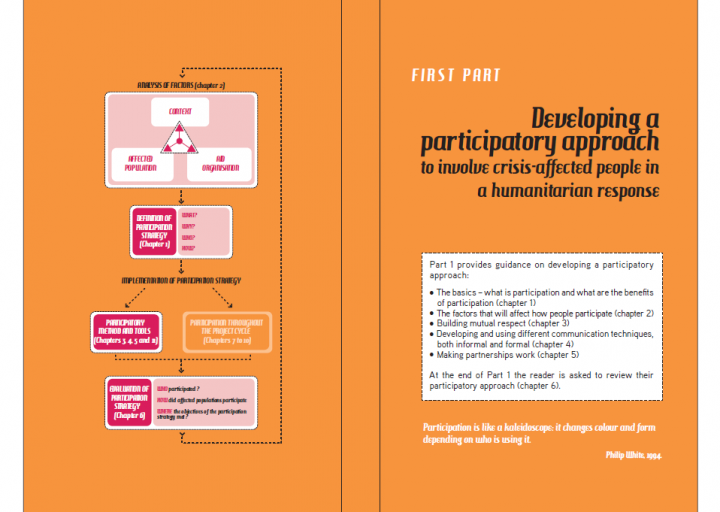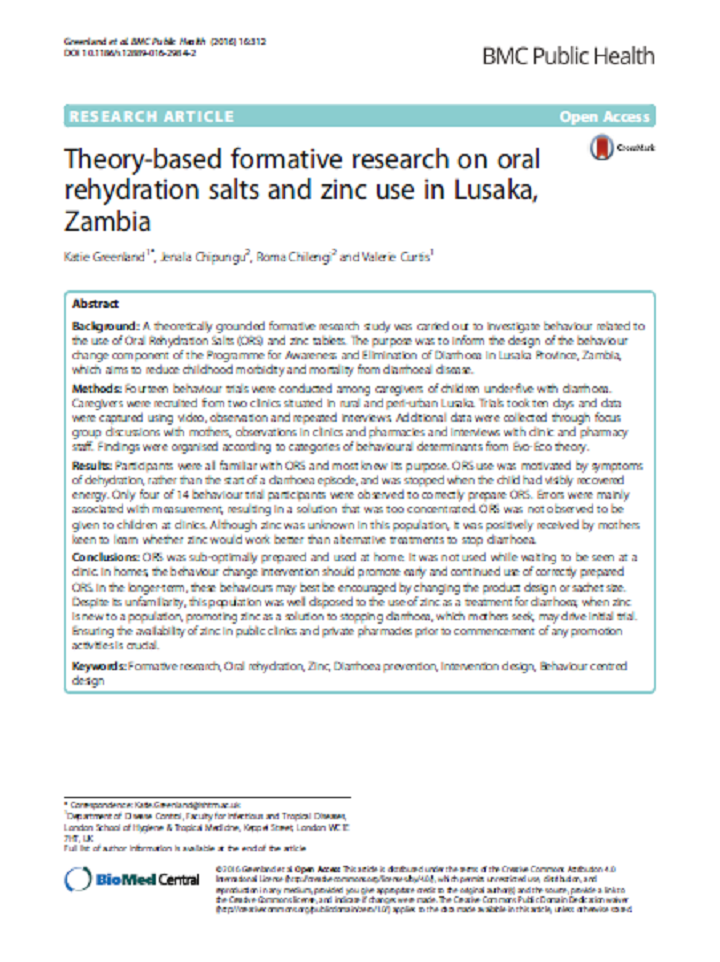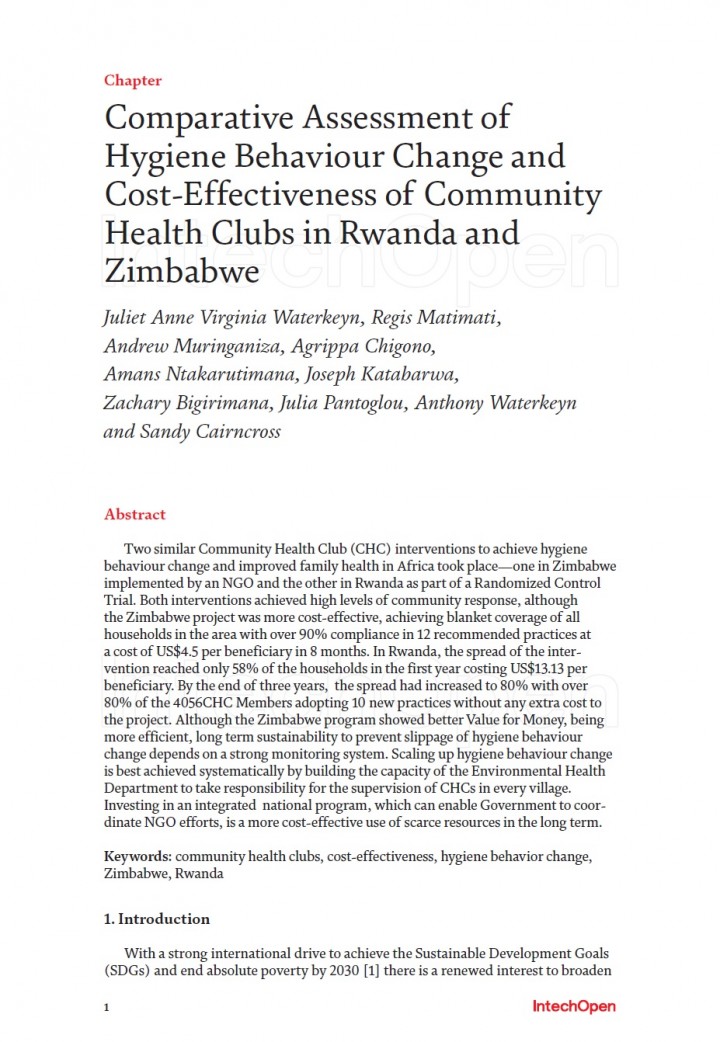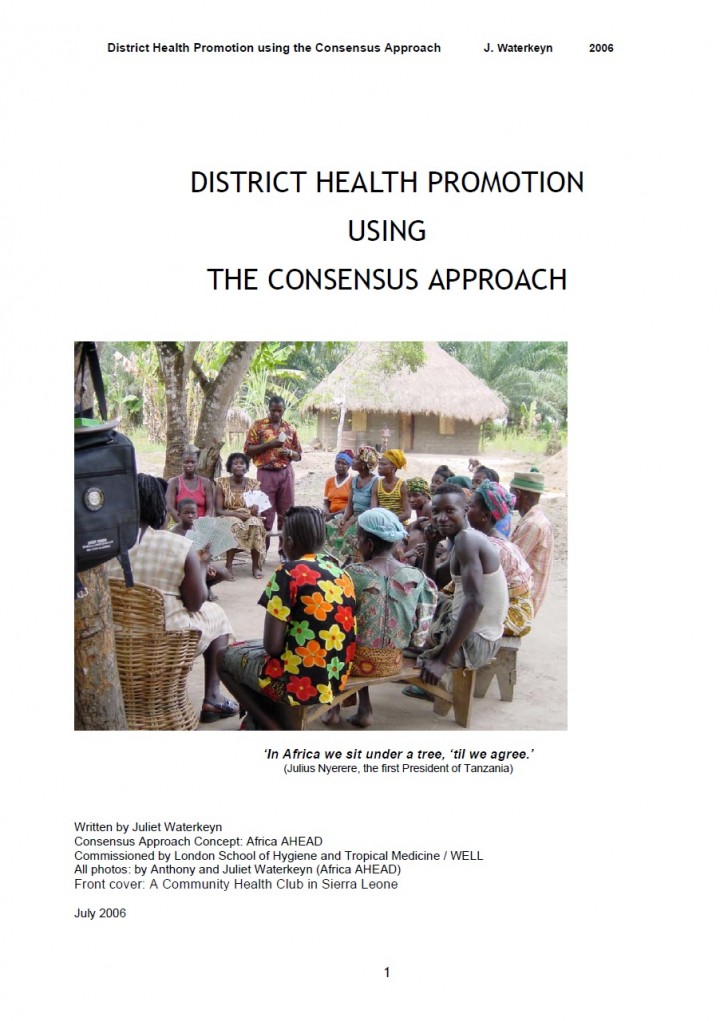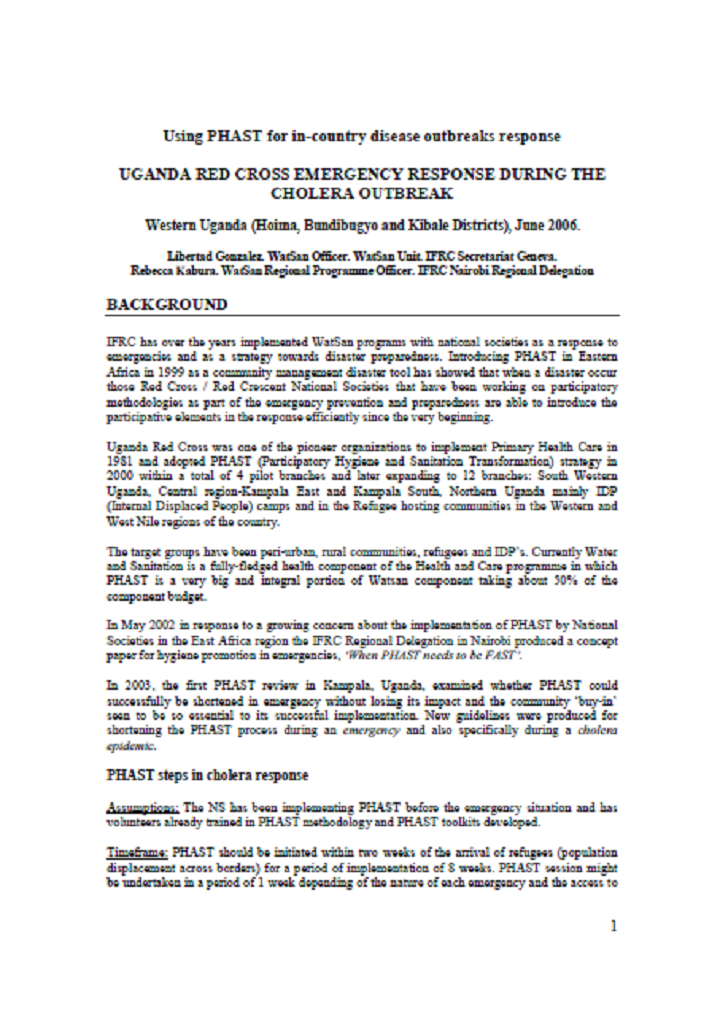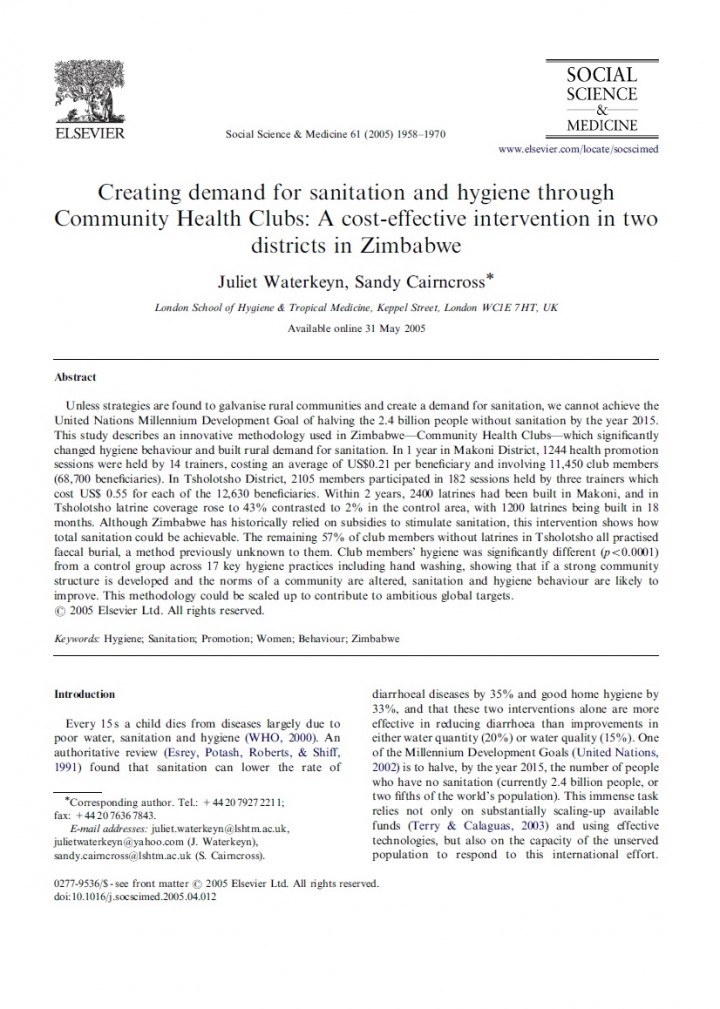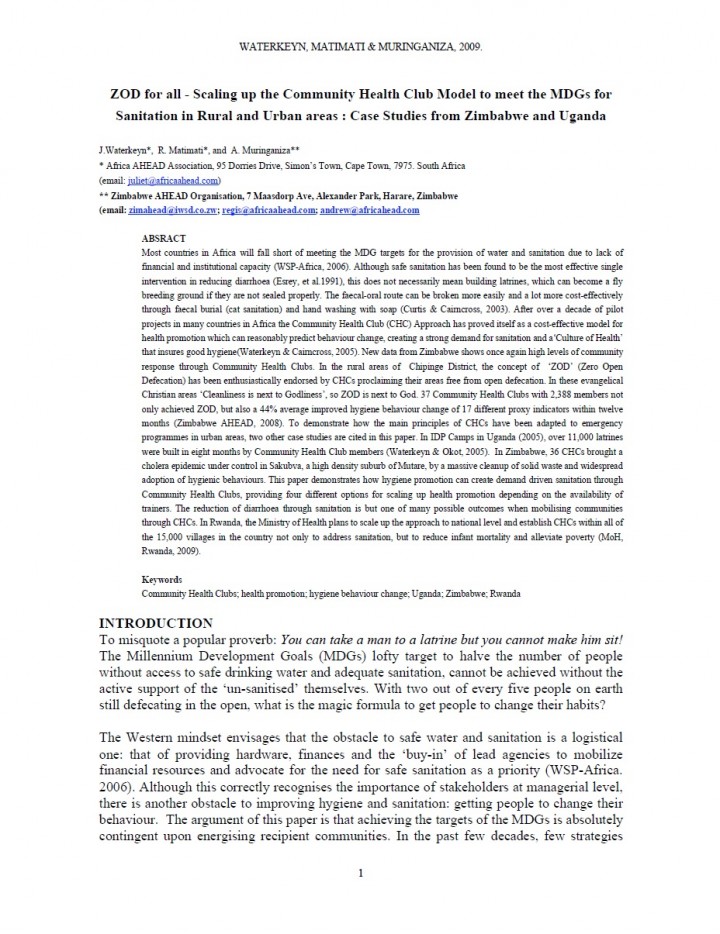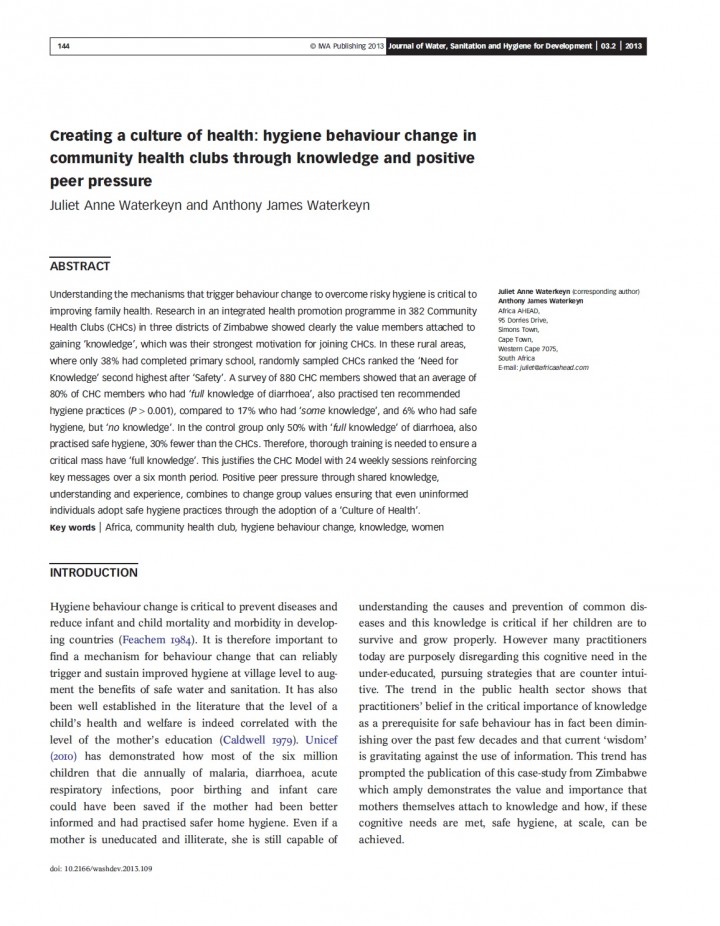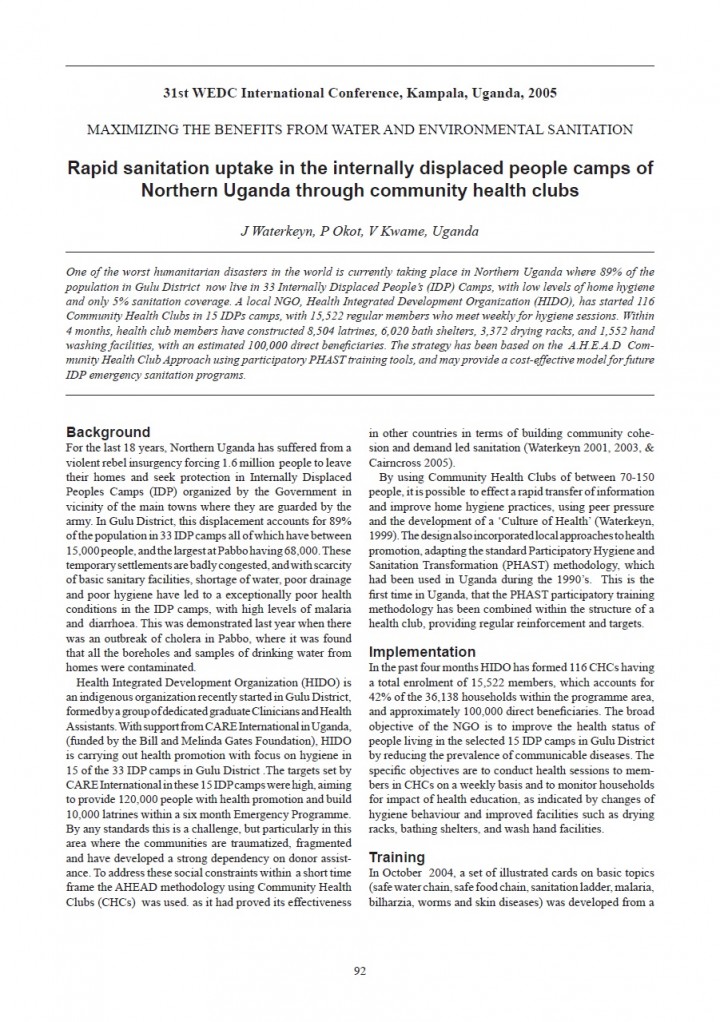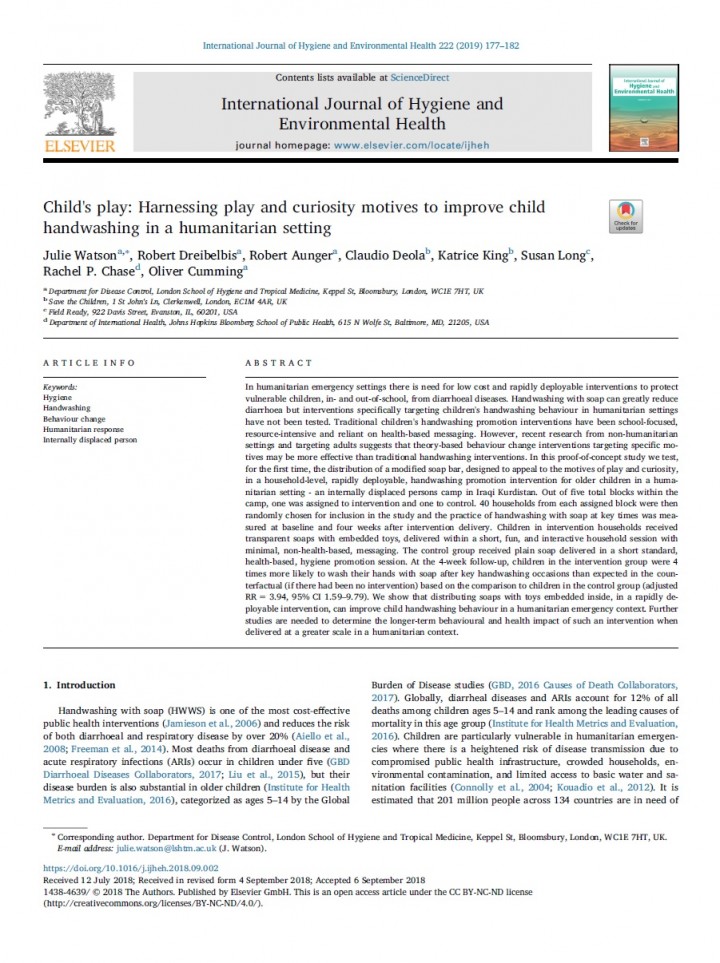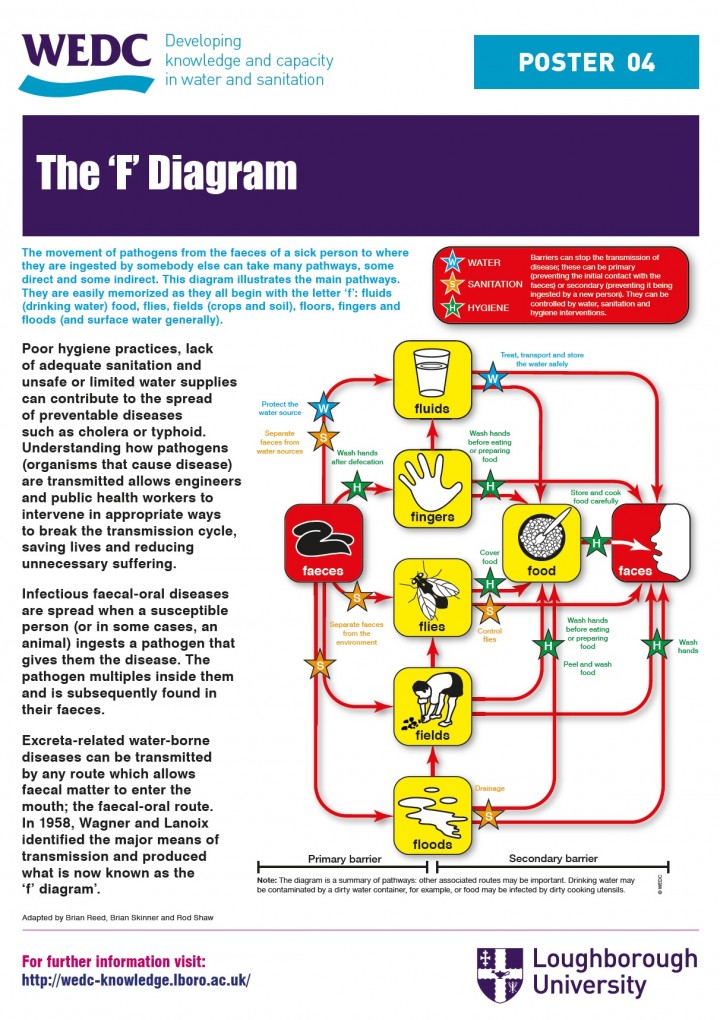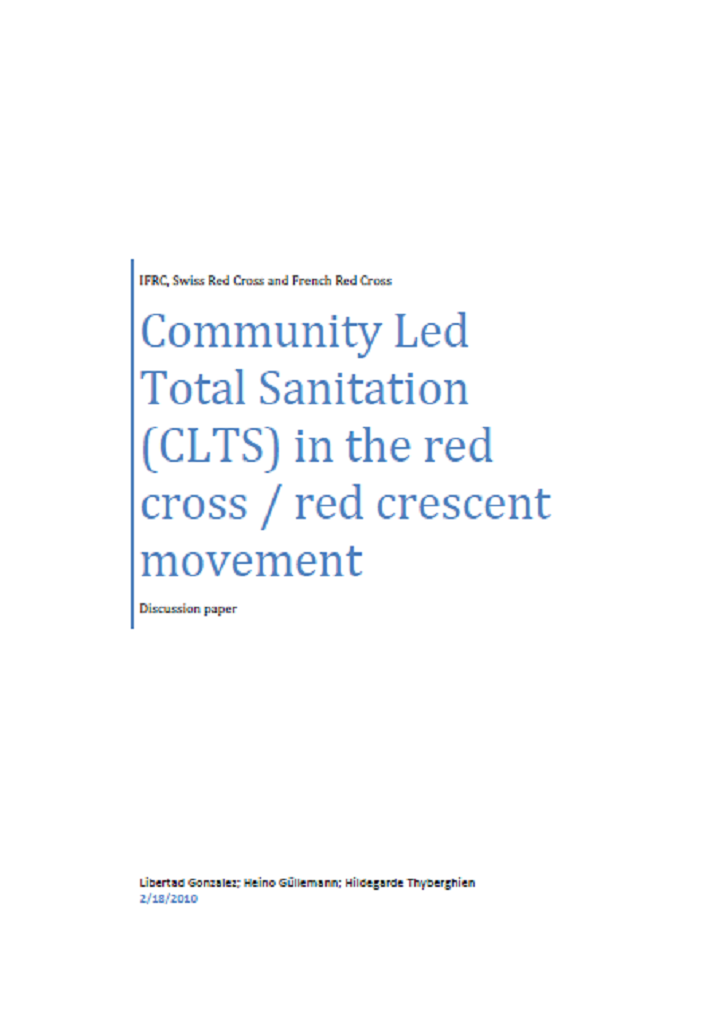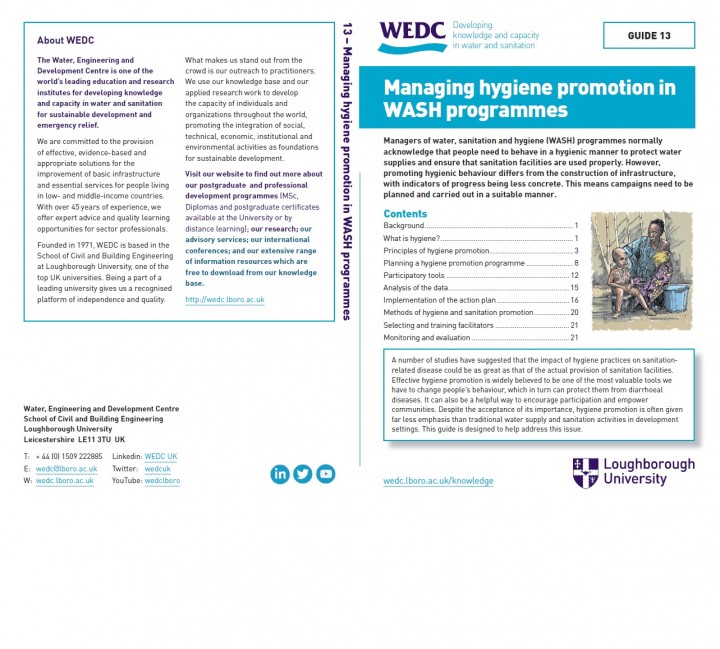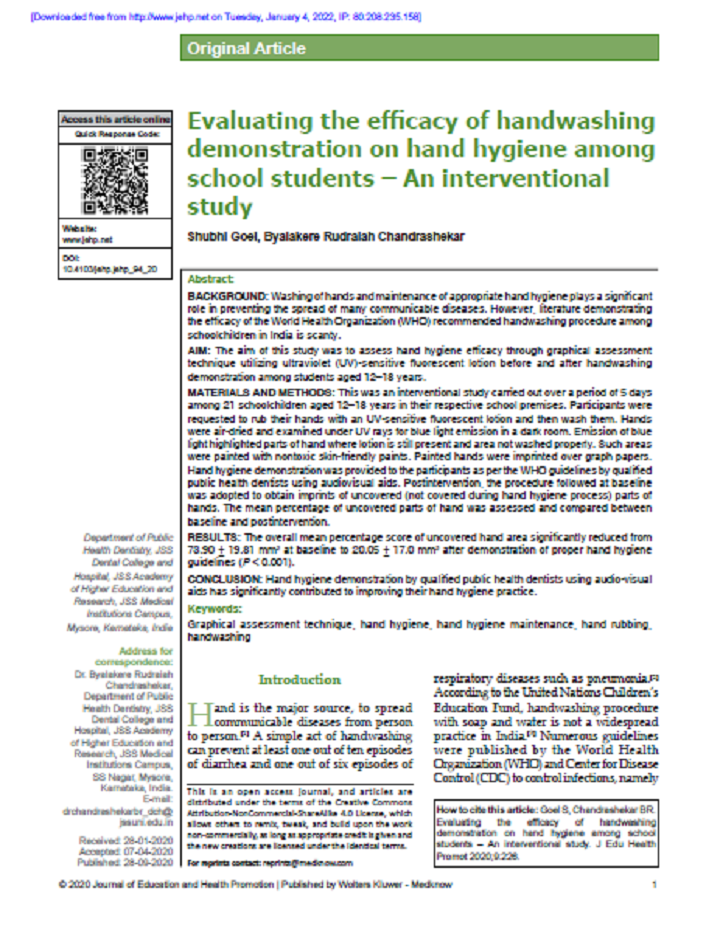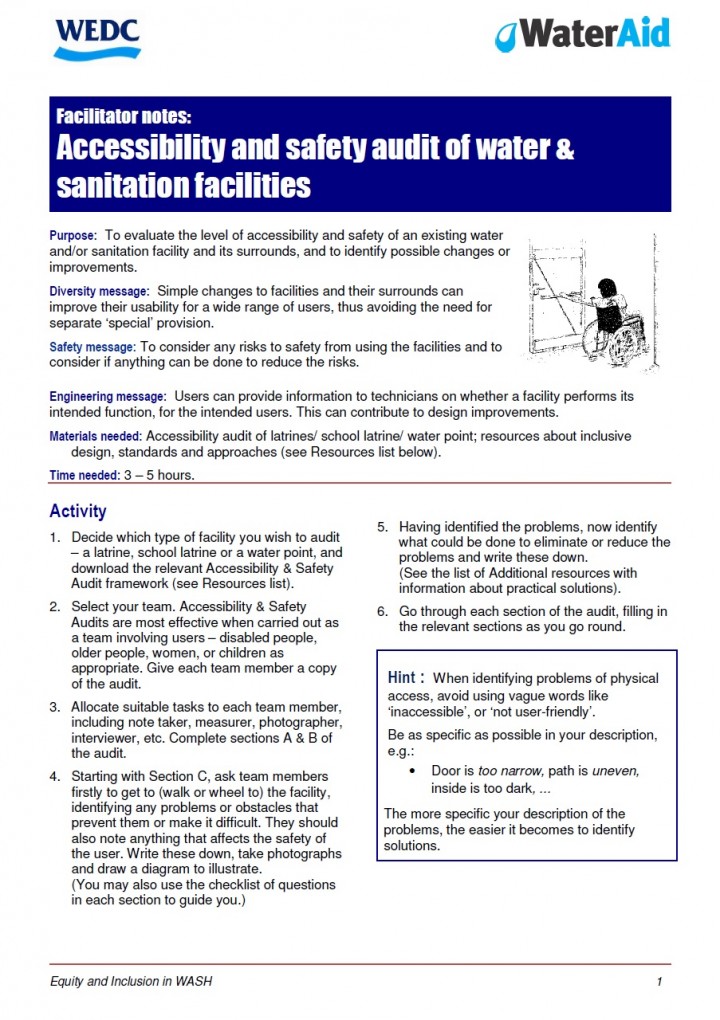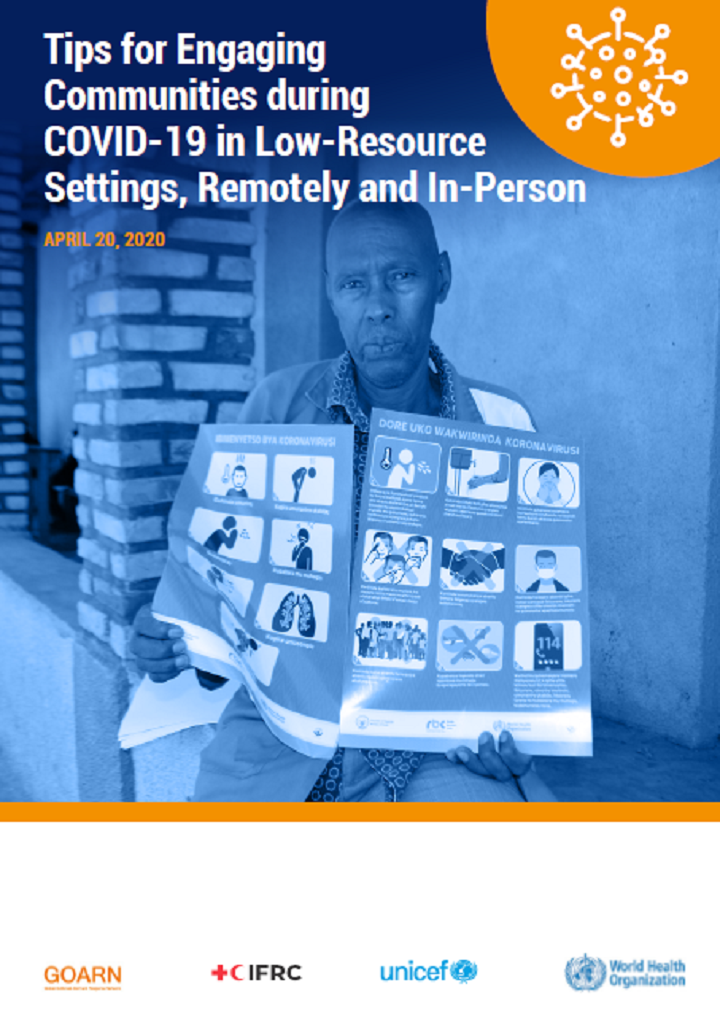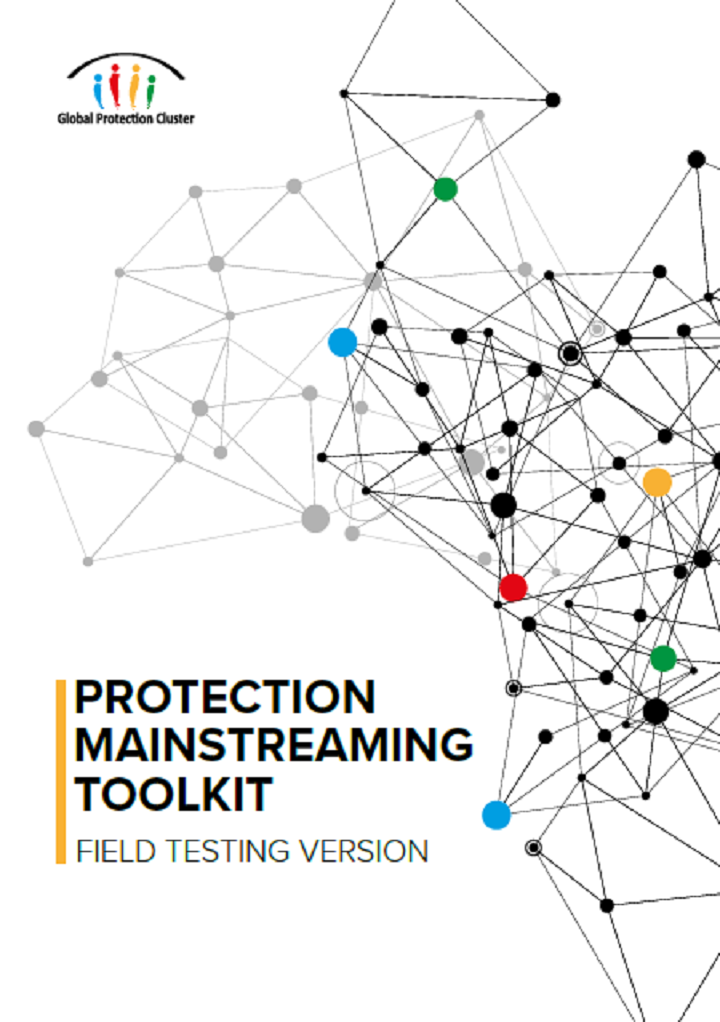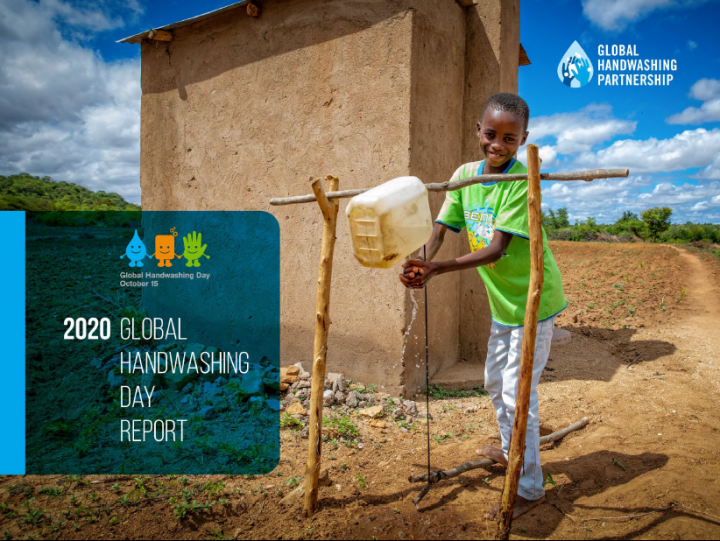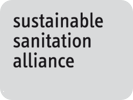Groupe URD (2009) Participation Handbook for Humanitarian Field Workers. Chapter 1-7
The Participation Handbook for humanitarian field workers contains detailed practical advice on the participation of affected people in humanitarian action. It has three sections: Developing a participatory approach (main issues, key factors, building mutual respect, communication methods and advice on reviewing your approach); Implementing your participatory approach at every stage of the project cycle (initial assessment, project design, implementation, monitoring and final evaluation); A list […]
Greenland, K., Chipungu, J., Chilengi, R., Curtis, V. (2016) Theory-Based Formative Research on Oral Rehydration Salts and Zinc Use in Lusaka, Zambia
Fourteen behaviour trials were conducted among caregivers of children under-five with diarrhoea. Caregivers were recruited from two clinics situated in rural and peri-urban Lusaka. Trials took ten days and data were captured using video, observation and repeated interviews. Additional data were collected through focus group discussions with mothers, observations in clinics and pharmacies and interviews with clinic and pharmacy staff. Findings were organised according to […]
Waterkeyn, J., Matimati, R., Muringaniza, A., Chigono, A., Ntakarutimana, A., Katabarwa, J., Bigirimana, Z., Pantoglou, J., Waterkeyn A., Cairncross, S. (2019) Comparative Assessment of Hygiene Behaviour Change and Cost-Effectiveness of Community Health Clubs in Rwanda and Zimbabwe
Two similar Community Health Club (CHC) interventions to achieve hygiene behaviour change and improved family health in Africa took place—one in Zimbabwe implemented by an NGO and the other in Rwanda as part of a Randomized Control Trial. Both interventions achieved high levels of community response, although the Zimbabwe project was more cost-effective, achieving blanket coverage of all households in the area with over 90% […]
Waterkeyn, J. (2006) District Health Promotion Using the Consensus Approach
This manual is a guideline for those planners looking for a practical methodology for conducting a health promotion project at District Level. The focus is primarily on applying this approach to rural areas; however the approach is still applicable to an urban setting. The manual takes approximately 1.5 hours to read and is divided into three main sections.
Gonzalez, L., Kabura, R. (2006) Using PHAST for In-Country Disease Outbreaks Response
Waterkeyn, J., Cairncross, S. (2005) Creating Demand for Sanitation and Hygiene Through Community Health Clubs A Cost-Effective Intervention in Two Districts in Zimbabwe
Unless strategies are found to galvanise rural communities and create a demand for sanitation, we cannot achieve the United Nations Millennium Development Goal of halving the 2.4 billion people without sanitation by the year 2015. This study describes an innovative methodology used in Zimbabwe—Community Health Clubs—which significantly changed hygiene behaviour and built rural demand for sanitation. In 1 year in Makoni District, 1244 health promotion […]
Waterkeyn, J., Matimati, R., Muringaniza, A. (2009) ZOD for all - Scaling up the Community Health Club Model to Meet the MDGs for Sanitation in Rural and Urban Areas Case Studies from Zimbabwe and Uganda
Most countries in Africa will fall short of meeting the MDG targets for the provision of water and sanitation due to lack of financial and institutional capacity (WSP-Africa, 2006). Although safe sanitation has been found to be the most effective single intervention in reducing diarrhoea (Esrey, et al.1991), this does not necessarily mean building latrines, which can become a fly breeding ground if they are […]
Waterkeyn, J., Waterkeyn, A. (2013) Creating a Culture of Health: Hygiene Behaviour Change in Community Health Clubs Through Knowledge and Positive Peer Pressure
Understanding the mechanisms that trigger behaviour change to overcome risky hygiene is critical to improving family health. Research in an integrated health promotion programme in 382 Community Health Clubs (CHCs) in three districts of Zimbabwe showed clearly the value members attached to gaining ‘knowledge’, which was their strongest motivation for joining CHCs. In these rural areas, where only 38% had completed primary school, randomly sampled […]
Waterkeyn, J., Waterkeyn, A., Uwingabire, F., Pantoglou, J., Ntakarutimana, A., Mbirira, M., Katabarwa, J., Bigirimana, Z., Cairncross, S., Carter, R. (2020) The Value of Monitoring Data in a Process Evaluation of Hygiene Behaviour Change in Community Health Clubs to Explain Findings from a Cluster-Randomised Controlled Trial in Rwanda
Background: A cluster-Randomised Controlled Trial evaluation of the impact of the Community Health Clubs (CHCs) in the Community Based Environmental Health Promotion Programme in Rwanda in 2015 appeared to find little uptake of 7 hygiene indicators 1 year after the end of the intervention, and low impact on prevention of diarrhoea and stunting. Methods: Monitoring data was revisited through detailed community records with all the expected inputs, outputs […]
Waterkeyn, J., Okot, P., Kwame, V. (2005) Rapid Sanitation Uptake in the Internally Displaced People Camps of Northern Uganda Through Community Health Clubs
One of the worst humanitarian disasters in the world is currently taking place in Northern Uganda where 89% of the population in Gulu District now live in 33 Internally Displaced People’s (IDP) Camps, with low levels of home hygiene and only 5% sanitation coverage. A local NGO, Health Integrated Development Organization (HIDO), has started 116 Community Health Clubs in 15 IDPs camps, with 15,522 regular […]
Watson, J., Dreibelbis, R., Aunger, R., Deola, C., King, K., Long, S., Chase, R. P., Cumming, O. (2018) Child's Play: Harnessing Play and Curiosity Motives to Improve Child Handwashing in a Humanitarian Setting
Abstract In humanitarian emergency settings there is need for low cost and rapidly deployable interventions to protect vulnerable children, in- and out-of-school, from diarrhoeal diseases. Handwashing with soap can greatly reduce diarrhoea but interventions specifically targeting children's handwashing behaviour in humanitarian settings have not been tested. Traditional children's handwashing promotion interventions have been school-focused, resource-intensive and reliant on health-based messaging. However, recent research from non-humanitarian settings […]
Gonzales, L., Güllemann, H., Thyberghien, H. (2010) Community Led Total Sanitation in the Red Cross / Red Crescent Movement. Discussion Paper
PHAST shares the same participatory learning principles as CLTS, which aim at gaining self-esteem, believing in people‟s ability to solve basic problems with their own resources. PHAST and CLTS also have in common the technical scope in their original conception, since both have been designed to focus on sanitation issues in rural communities. However, PHAST in Red Cross / Red Crescent has been successful in […]
Reed, B., Bevan, J. (2014) Managing Hygiene Promotion in WASH Programmes Guide 13
Managers of water, sanitation and hygiene (WASH) programmes normally acknowledge that people need to behave in a hygienic manner to protect water supplies and ensure that sanitation facilities are used properly. However, promoting hygienic behaviour differs from the construction of infrastructure, with indicators of progress being less concrete. This means campaigns need to be planned and carried out in a suitable manner. A number of […]
Goel, S., Chandrashekar, B.R. (2020) Evaluating the Efficacy of Handwashing Demonstration on Hand Hygiene Among School Students. An Interventional Study
This was an interventional study carried out over a period of 5 days among 21 schoolchildren aged 12–18 years in their respective school premises. Participants were requested to rub their hands with an UV-sensitive fluorescent lotion and then wash them. Hands were air-dried and examined under UV rays for blue light emission in a dark room. Emission of blue light highlighted parts of hand where […]
WEDC, WaterAid (2013) Accessibility and Safety Audit of Water and Sanitation Facilities Facilitators Notes
Purpose: To evaluate the level of accessibility and safety of an existing water and/or sanitation facility and its surrounds, and to identify possible changes or improvements. Diversity message: Simple changes to facilities and their surrounds can improve their usability for a wide range of users, thus avoiding the need for separate ‘special’ provision. Safety message: To consider any risks to safety from using the facilities and to […]
GOARN, IFRC, UNICEF, WHO (2020) Tips for Engaging Communities during COVID-19 in Low-Resource Settings, Remotely and In-Person
This brief provides key considerations for engaging communities on COVID-19 and tips for how to engage where there are movement restrictions and physical distancing measures in place, particularly in low-resource settings. It is designed for non-governmental organizations (NGOs), UN agencies, government agencies, and other humanitarian and implementing actors working on health promotion, risk communication, and community engagement for COVID-19. This document is an initiative of […]
WEDC, WaterAid (2013) Accessibility and Safety Audit: Latrine Checklist
The purpose is to examine a sanitation facility, and a) Find out if a physically vulnerable person1 is able to use the facility independently. b) Identify which features make it easy to use, and which features make it difficult to use by a physically vulnerable person. c) Find out if there are any safety concerns around using the facility, particularly for adolescent girls, women and children of different ages. d) Identify […]
Global Protection Cluster (0) Protection Mainstreaming Toolkit. Field Testing Version
Global Handwashing Partnership (2021) 2020 Global Handwashing Day Report
